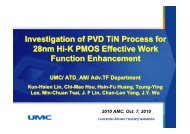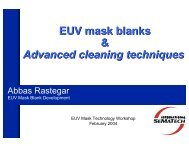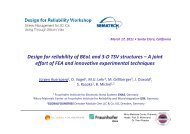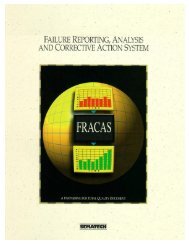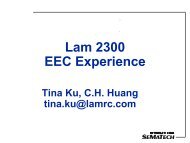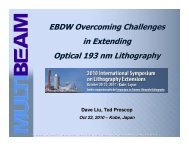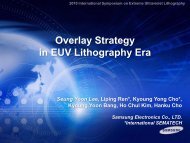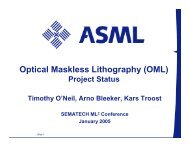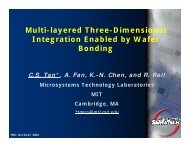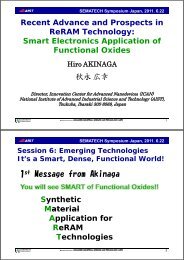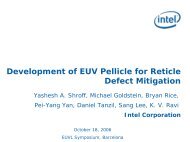Immersion Lithography - Sematech
Immersion Lithography - Sematech
Immersion Lithography - Sematech
Create successful ePaper yourself
Turn your PDF publications into a flip-book with our unique Google optimized e-Paper software.
Design for Controllability:<br />
<strong>Immersion</strong> <strong>Lithography</strong><br />
International Symposium on <strong>Immersion</strong><br />
and 157nm <strong>Lithography</strong><br />
August 2004<br />
Christopher Bode, Joyce Oey, Robert Chong
Outline<br />
•Introduction<br />
• Automated Precision Manufacturing<br />
– Advanced Process Control<br />
– Yield Management Systems<br />
– Integrated Production Scheduling<br />
• Design For Controllability<br />
–Concept<br />
–Scope<br />
–Process<br />
• Design For Controllability Opportunity<br />
– <strong>Immersion</strong> <strong>Lithography</strong> - Overview<br />
– Defining the Challenge<br />
– Characterization<br />
• Supplier Collaboration<br />
2 of 27
Introduction<br />
Maximizing Manufacturing Efficiency<br />
Yield<br />
Management<br />
Systems<br />
Integrated<br />
Production<br />
Scheduling<br />
Equipment<br />
Performance<br />
Optimization<br />
APM<br />
Product<br />
Performance<br />
Targeting<br />
Advanced<br />
Process<br />
Control<br />
What is Automated Precision<br />
Manufacturing (APM)?<br />
• Integrated suite of more than 200 AMD<br />
patented or patent-pending technologies<br />
• Foundation of AMD’s manufacturing<br />
strength and competitiveness<br />
• Allows aggressive participation in<br />
stringent product performance markets<br />
• Enabler for world-class operational<br />
metrics<br />
• Provides significant advantages in:<br />
– Manufacturing automation and control<br />
– Minimization of defective die<br />
– Continuous, customer-centric product<br />
improvements<br />
3 of 27
Advanced Process Control<br />
APC incorporates RtRPC and FDC<br />
(from<br />
Previous<br />
tool)<br />
Feedforward<br />
Automated<br />
Fault<br />
Detection<br />
Run-to Run to-Run Run<br />
Controller<br />
Process<br />
Model<br />
Updated<br />
Recipe<br />
Real Time<br />
Equipment<br />
Controller<br />
Equipment<br />
Model<br />
Sensor Data<br />
Modified<br />
Recipe<br />
Equipment<br />
State<br />
Process<br />
State<br />
Control Unit Operation<br />
Run-to-Run Control (RtR): automatic change<br />
in the process recipe for a given run based on<br />
feed-back data from post-process metrology and<br />
feed-forward data from previous operations.<br />
Fault Detection and Classification (FDC):<br />
automatic determination of abnormal equipment<br />
state, execution of halts/alarms, and assignment<br />
of the cause of detected faults.<br />
Post Process Metrology Data<br />
In-Situ Sensors<br />
Process<br />
Noise<br />
Wafer<br />
State<br />
Measurement<br />
Noise<br />
Metrology<br />
4 of 27<br />
(to<br />
next<br />
tool)
Wafer Level Control<br />
• Lot–to–Lot variation is generally solved today<br />
• WtW and wafer uniformity issues are becoming dominant<br />
• Example speed map:<br />
Relationships:<br />
• Speed ∼ 1/L eff<br />
• L eff = f(CD,other effects)<br />
• CD ⇒ L eff ⇒ Speed<br />
Use WtW/FtF (within wafer) control capabilities for next level<br />
of product improvement!<br />
5 of 27
Yield Management at the Wafer Level<br />
• Wafer level tracking allows for faster diagnosis of yield related<br />
issues<br />
– OOC data can be linked to wafer positions<br />
– Wafer positions can be correlated to processing tools and chambers<br />
– Chambers with issues can be quickly identified and addressed.<br />
OOC Data<br />
Wafer Position<br />
Analysis<br />
Chamber<br />
Identified<br />
6 of 27
300mm Advanced Process Control<br />
Wafer Level Control and Dynamic Sampling<br />
• With the increased cost and<br />
complexity comes the<br />
imperative need to ensure<br />
each wafer is processed to<br />
target<br />
– Wafer-level becomes critical<br />
to eliminating sources of<br />
variation.<br />
• Dynamic Sampling enables<br />
wafer level control<br />
– Allows for collection of more<br />
information from the same<br />
amount of data<br />
– Reduces the need for<br />
metrology capital<br />
Lot-to-Lot Control<br />
Wafer-to-Wafer Control<br />
Within-Wafer Control<br />
7 of 27
Fab-Wide Control Technology<br />
Dynamic Defect Sampling<br />
P1 I<br />
P1 II<br />
P2 A P3 1<br />
P2 B<br />
P2 C<br />
P3 2<br />
P3 3<br />
I-B-2<br />
II-B-1<br />
I-A-2<br />
II-C-2<br />
Identify Lots for<br />
Metrology Sampling<br />
APC Framework: Sampling Application<br />
Defect<br />
Metrology<br />
• The Dynamic Defect Sampling application identifies tools that need<br />
increased sampling due to elevated defectivity.<br />
Metrology<br />
Results<br />
• It will also work with the dispatching system to reduce the uncertainty in<br />
which process tool is responsible for the increased defectivity.<br />
8 of 27
Design for Controllability (DFC)<br />
• Concept: Proactively identify control challenges and opportunities in<br />
order to engineer control solutions earlier in the development cycle<br />
of new tools, processes and product technologies.<br />
• Purpose: Better anticipate manufacturing challenges and develop<br />
solutions and methods in collaboration with suppliers early enough<br />
to deliver complete control solutions to the manufacturing<br />
organizations.<br />
• Control development to date has been after tools are received and<br />
installed in the fabs.<br />
– This type of development is limited in capability and scope by the tool<br />
and tool data availability.<br />
– Tool upgrades and tool software changes are much harder to justify<br />
after the initial tool purchase, limiting the ability to augment tool<br />
capabilities.<br />
– Identifying process control solutions and data access needs during the<br />
tool development phase is more efficient<br />
9 of 27
DFC Process<br />
1. Define the Challenge<br />
• Work with suppliers in conjunction with the process/technology<br />
development organizations to identify anticipated manufacturing<br />
challenges.<br />
• Identify the most critical APM (control, efficiency, & yield/performance)<br />
objectives.<br />
2. Characterization<br />
• Develop a comprehensive understanding of the challenge through<br />
process modeling and measurement technologies.<br />
• Identify specific tool sensors and tool data requirements including but<br />
not limited to data frequency, resolution, data type, etc. to support the<br />
best, manufacturable control methods to be transferred to<br />
manufacturing.<br />
3. Enhancement<br />
• Develop the necessary control capabilities to address the<br />
manufacturing challenges, in terms of tool, process and control<br />
capabilities.<br />
• Provide improved transfer packages that accelerates time to yield and<br />
control improvements during process introduction and ramp.<br />
10 of 27
Organizational Flow<br />
3.<br />
R&D<br />
FabA<br />
R&D FabB FabC<br />
2.<br />
APM - DFC<br />
2.<br />
Suppliers<br />
1.<br />
1.Define the Challenge:<br />
� Identify key objectives, roadmaps<br />
� Education (needs and opportunities)<br />
� ID most critical needs, establish program<br />
2.Characterization:<br />
� Enhance DOE’s<br />
� Gather data<br />
� Modeling/measurement technology<br />
� Define solution criteria<br />
− tool data<br />
− tool sensors<br />
� Identify most manufacturable options<br />
3.Enhancements:<br />
� Develop enhancements<br />
� Implement solutions<br />
� Augment transfer packages<br />
11 of 27
What is <strong>Immersion</strong> <strong>Lithography</strong>?<br />
• Definition: The introduction of a fluid (in this case, H 2 O) between<br />
the lens and the wafer to reduce or eliminate refraction at the<br />
liquid/lens and liquid/wafer interfaces reducing the effective<br />
wavelength of the light source.<br />
One way to increase the<br />
numerical aperture and<br />
refractive index is to employ<br />
immersion imaging.<br />
• This technology has subsystems for which factory-integrated,<br />
automated control systems have yet to be developed.<br />
12 of 27
<strong>Lithography</strong> Overview<br />
• Numerical Aperture (NA) is defined as the ability to collect<br />
light diffracted from a mask/reticle. The larger the NA the<br />
more light is collected. NA is limited by the diameter of the<br />
lens.<br />
• Resolution is the smallest feature that can be printed and is<br />
a function of NA. As NA increases and wavelengths decrease<br />
the resolution improves allowing us to print smaller features.<br />
λ<br />
resolution = k1<br />
NA<br />
λ =<br />
eff<br />
λ<br />
index<br />
• The index of refraction of H 2O is 1.43 at 193nm<br />
• Using H 2O as the immersion liquid results in an effective<br />
wavelength of approximately 135nm<br />
• This is where immersion becomes more attractive than<br />
157nm (dry) lithography<br />
13 of 27
DFC Opportunity:<br />
<strong>Immersion</strong> <strong>Lithography</strong><br />
•<strong>Immersion</strong> <strong>Lithography</strong> is among the new manufacturing<br />
techniques being introduced for the 45nm technology node.<br />
•This new alternative to optical lithography allows suppliers to<br />
push the limits of existing optical platforms and track<br />
systems without having to make expensive and less proven<br />
changes to photoresist systems, mask systems, light sources<br />
and optical components.<br />
•<strong>Immersion</strong> reportedly requires little change to the existing<br />
lithography infrastructure, but those that are required will<br />
give rise to challenging process/ tool control and fault<br />
detection issues in the realm of APM.<br />
14 of 27
More About <strong>Immersion</strong> <strong>Lithography</strong><br />
•Benefits<br />
– Extends current 193nm optical lithography beyond 65nm<br />
– Increases resolution and depth of focus required to support sub-<br />
65nm technology nodes<br />
– Relies on the same masks, resist and lens concepts of existing dry<br />
193nm systems<br />
•<strong>Immersion</strong> Sub-systems<br />
– Liquid Handling Systems<br />
– Optical Platform<br />
– <strong>Immersion</strong> Materials/ Sources<br />
–Liquid Interfaces<br />
15 of 27
Key to Success<br />
One of the keys to the<br />
success of advanced<br />
manufacturing for sub<br />
65-nm technology is<br />
the delivery of<br />
factory-integrated,<br />
automated control<br />
systems at first-tool<br />
install to speed yield<br />
and control<br />
improvements during<br />
process introduction<br />
and ramp…<br />
16 of 27
Defining the Challenge<br />
• This initial stage of development seeks to fully identify the scope<br />
and nature of a given manufacturing challenge.<br />
– The highest priority immersion control challenges have been defined by<br />
our technology development organizations in conjunction with ISMT<br />
immersion lithography programs<br />
• By working closely with our Strategic <strong>Lithography</strong> Team we are in<br />
the process of identifying the following:<br />
�Requirements for tool sensors, data availability, data types, frequency,<br />
resolution, etc. necessary for developing control capabilities to address<br />
immersion manufacturing challenges.<br />
– Sources of variability related specifically to the imaging step that<br />
influences the ability to meet process window requirements.<br />
– Potential fault conditions that may affect yield, product and/ or tool<br />
performance.<br />
– Dependencies on incoming substrate properties that can be used for the<br />
development of feedforward, closed-loop control.<br />
– Defects caused by the immersion subsystems that need to be controlled.<br />
17 of 27
DFC Opportunity #1<br />
If we know…<br />
Bubbles<br />
water flow<br />
conditions<br />
pressure wafer stage velocity<br />
we can<br />
predict and<br />
prevent…<br />
18 of 27
<strong>Immersion</strong> Challenge<br />
•Bubble Defects<br />
– The most potentially serious issue facing immersion lithography<br />
– Sources of Bubbles[2]<br />
• Dissolved gases precipitate out of the solution<br />
• Turbulent flow conditions during the liquid fill<br />
• Reactions between the immersion liquid and the resist<br />
• Wafer stage velocity<br />
• Other process steps related to the coat and develop steps<br />
• Impact of Bubbles on Imaging:<br />
– Extent of the effect depends on bubble size, location & density<br />
• Large micron-scale bubbles behave like particles blocking the<br />
image[1]<br />
• Smaller, nanometer-scale bubbles can degrade contrast and blur the<br />
edges of features [1]<br />
• The effects of bubbles on yield still needs to be investigated,<br />
however, the ability to detect bubbles and classify them may aid<br />
process engineers in proactively resolving issues with the immersion<br />
sub-systems, ie. temperature, flow rate, vibrations.<br />
19 of 27
Bubble and Fault Detection System<br />
pressure stage velocity H 2 O flow rate<br />
Stepper Trace Data<br />
Yield Management System<br />
− Based on the FDC Charts adjust<br />
the dynamic sampling program<br />
to allow for the collection of<br />
more or less information (ie.<br />
more sites/wafer, or /flash)<br />
− Work with process and<br />
technology integration to model<br />
correlation between critical<br />
immersion variables and bubble<br />
formation<br />
Prediction<br />
− Calculate probability of bubble<br />
defects as a function of critical<br />
immersion variables<br />
Fault Detection Charts (FDC)<br />
− detects trends and faults that<br />
may indicate the possible<br />
formation of bubbles<br />
− Alarm within or after run<br />
− Stop next run if necessary<br />
20 of 27
DFC Opportunity #2<br />
• Scan speed and dispense/water flow thru wafer to control<br />
within die uniformity.<br />
Stepper<br />
DICD uniformity<br />
Scan Speed<br />
Dispense<br />
Water Flow<br />
DICD<br />
FICD uniformity<br />
Etcher<br />
Etcher<br />
Etcher<br />
FICD<br />
To build a control model<br />
correlations need to be<br />
derived for the following<br />
variables:<br />
Output Process<br />
Knob<br />
DICD uniformity<br />
FICD uniformity<br />
scan speed<br />
dispense<br />
velocity<br />
water flow<br />
rate<br />
DICD uniformity<br />
21 of 27
Characterization<br />
• Characterization involves developing a process model,<br />
developing the necessary measurement technology and<br />
ensuring there is adequate tool visibility and controls to<br />
support the derived process model or fault detection<br />
program.<br />
• Modeling provides the necessary understanding of how<br />
inputs into the process affect the resulting quality metrics or<br />
how the trace data correlates to tool performance, defect<br />
predictions, and dynamic sampling adjustments.<br />
– Sensitivities to recipe adjustments and incoming wafer<br />
properties are characterized.<br />
– Sensitivities to specific tool variables that may affect yield,<br />
defect formations, reworks, etc. are characterized.<br />
– Predictive yield and product performance models allow for the<br />
identification of process targeting.<br />
22 of 27
Characterization (cont.)<br />
• Measurement technology provides visibility into the process<br />
to support ongoing modeling and control objectives.<br />
�Collaboration with suppliers will be essent when the<br />
necessary tool controls and trace data are unavailable to<br />
support the process model and/or fault detection programs.<br />
• Much of the characterization described above is already<br />
performed. This collaboration would seek to leverage that<br />
existing information, perhaps augment it with additional<br />
information, to facilitate control development.<br />
23 of 27
Supplier Collaboration<br />
How We Will Achieve Success<br />
FabA<br />
R&D<br />
FabC<br />
FabB<br />
R&D<br />
Effective Collaboration<br />
•Participate in regular face-to-face meetings to ensure clear<br />
communication.<br />
APM “DFM”<br />
•Define the Challenge together to meet the needs of all parties.<br />
•Generate standard documentation during Characterization.<br />
•Deliver APM Programs (RtR and FDC) using currently available and<br />
jointly developed utilities.<br />
24 of 27
Final Thoughts<br />
• Defining the challenge and developing control solutions during the<br />
design and beta stages of tool development will allow us to deliver<br />
factory-integrated, automated control systems at first-tool install to<br />
speed yield and control improvements during process introduction<br />
and ramp.<br />
• Using <strong>Immersion</strong> <strong>Lithography</strong> as an example we have illustrated the<br />
DFC concept and its desired outcome.<br />
• DFC encourages supplier collaboration to ensure adequate tool<br />
controls and trace data are available to support the process models<br />
and fault detection programs<br />
• For 300mm manufacturing DFC enables us to better anticipate<br />
manufacturing challenges and develop solutions and methods in<br />
collaboration with suppliers early enough to deliver complete control<br />
solutions to the manufacturing organizations.<br />
25 of 27
References<br />
[1] Derbyshire, Katherine, Optical <strong>Lithography</strong>’s Liquid Future,<br />
Semiconductor Manufacturing, March 2004, Volume 5,<br />
Issue 3.<br />
[2] Kandlikar, Staish G., Bubble Entrapement In Liquid<br />
<strong>Immersion</strong> <strong>Lithography</strong>, SEMATECH <strong>Immersion</strong><br />
<strong>Lithography</strong> Workshop, January 27, 2004.<br />
26 of 27
Trademark Attribution<br />
AMD, the AMD Arrow Logo and combinations thereof are<br />
trademarks of Advanced Micro Devices, Inc. Other product<br />
names used in this presentation are for identification purposes<br />
only and may be trademarks of their respective companies.<br />
27 of 27



